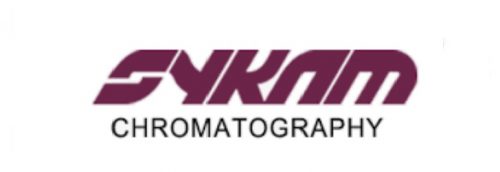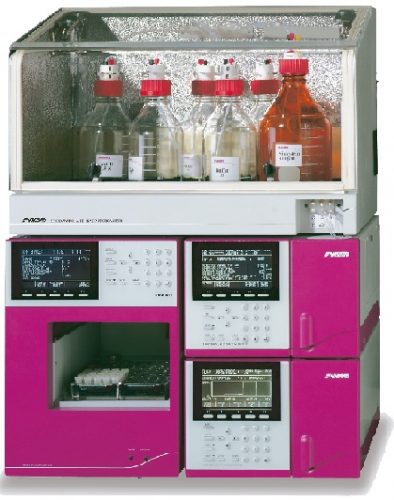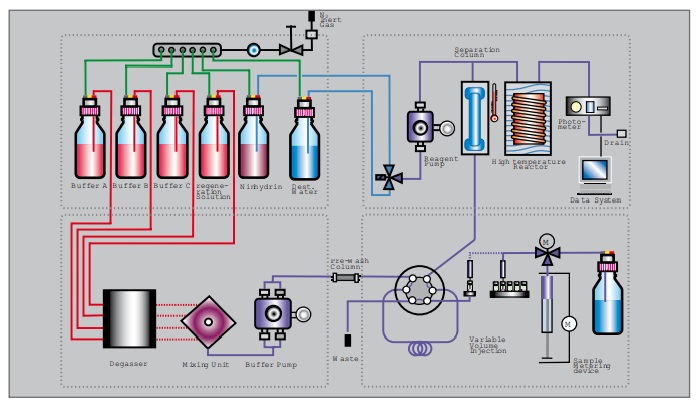

S 433 Automatic Amino Acid Analyser
The innovative automatic Amino Acid Analyzer S 433 combines the advantages of the classical ion exchange separation method with the modern technique of high performance liquid chromatography. The complete package of sophisticated instrumentation, a wide variety of prepacked and tested separation columns, combined with optimized ready-to-use buffer solutions and chemicals, creates the right answer for any routine or research problem in amino acid determination. More than 30 years experience in developing and operating sophisticated amino acid analyzers results in unmatched performance.
Automatic Amino Acid Analyzer S 433
The innovative automatic Amino Acid Analyzer S 433 combines the advantages of the classical ion exchange separation method with the modern technique of high performance liquid chromatography. The complete package of sophisticated instrumentation, a wide variety of prepacked and tested separation columns, combined with optimized ready-to-use buffer solutions and chemicals, creates the right answer for any routine or research problem in amino acid determination. More than 30 years experience in developing and operating sophisticated amino acid analyzers results in unmatched performance.
Multistep Separation
Only two or three buffer solutions have to be combined to form the best optimized buffer profile at any part of the separation program. No more compromises by the limitation to four or five buffer changes.
Cooled Reagent Storage
All buffer solutions, as well as the Ninhydrine reagent are stored under inert gas pressure in a refrigerated cabinet to avoid oxidation and air contamination independent of the ambient environment.
Integrated Autosampler
with a capacity of 120 vials in a cooled sample tray.
Volumes from 1µl to 100 µl can be injected without any loss of sample. The injected volume is adjusted by a high precision syringe, driven by a stepper motor with a resolution
of 17 steps per µl. A programmable wash program will flush the entire injection system to avoid cross contamination of the sample.
Integrated Vacuum Degasser
avoids the interruption of the buffer pump by air bubbles without the need of bubble traps with varying volumes, causing changes in retention times of the different amino acids.
Separation Column Oven
integrated solid state column oven with fast heating and cooling capability with a temperature range from +20°C to +99°C independent of the ambient temperature. Up
to twelve programmable temperature steps can be used during one separation program.
High-Temperature Reactor
with a programmable temperature range from ambient to 180°C with a coiled capillary for the color reaction of the amino acid-ninhydrine complex. Automatic flushing of the reactor coil with a washing solution after each run prevents the blockage of the capillary.
Integrated Reagent Dosing Pump
for Ninhydrine delivery and flushing of the reaction coil after each run. Programmable flow rate from 0.01 to 2.0 ml/min.
Complete Inert Design
All materials coming into contact with the buffer solutions and reagents are made of inert materials as PEEK, PTFE, PVDF etc. Therefore, there is no need for using special non-corrosive buffer compositions or reagents.
Integrated Dual-Channel Photometer
Tungsten Lamp
Lense Flowcell Lense
440 nm Sensor
570 nm Sensor
Splitting Mirror for the amino acid detection at 440 nm and 570 nm wavelengths.
Summing option for both channels, for single channel integration of all amino acids.
Safety Devices
control pump pressures, temperatures and leakages.
Optional Application
– Post column derivatisation with OPA (needs an optional Fluorescence Detector)
– Carbohydrate determination for reducing sugars with Cu-bicinchoninate post-column derivatisation (except the separation column, no additional extras are needed)
– Polyamine determination with Ninhydrine or OPA postcolumn derivatisation.

S433 Amino Acid Analyzer control and data handling software
The S433 control and data handling software is based on the DataApex Clarity chromatography data station (CDS). Although the user is free to use any other CDS, the control software stores at all times the analysis, including all system parameters of the separation program including the actual buffer pressure, reagent pressure and column temperatures during the run. The S433 control and data handling software is FDA 21 CFR part 11 compliant for use in GxP regulated laboratories. See some examples of the control software below

Fig.1. The S433 Device Monitor screen shows the actual status of the key parameters during a run.

Fig.2. The data acquisition screen with the actual gradient visualized with a different color for each buffer as background of the running chromatogram.

Fig. 3. All method parameters are stored within the chromatogram datafile. Buffer gradient, column temperature gradient, integration and calculation parameters as well as the actual buffer- and reagent pressure and actual column temperature are recorded during the run. The buffer gradient program is shown here as one of the tabs of the method screen.


Fig.4. The column temperature program.

Fig. 5. Choosing to record additional signals: actual flow, buffer pressure, reagent pressure, column and reactor temperature

Fig. 6. Example of a result screen.
Sykam S433 Amino Acid Analyzer applications
An application for an amino acid analyzer is defined by a separation column, a set of buffers and the list of amino acids to be separated from each other as well as from any disturbing substances present in the samples that could or are likely to appear in the chromatogram. Standard applications are available for complete analysis of hydrolysates, oxidized feedstuff hydrolysates and physiological fluids along with a number of short programs when only some amino acids need to be determined.
- The key parameters for achieving a good separation of the amino acids are – apart from the cation-exchange column itself – eluent pH, eluent molarity, the column temperature gradient and to some extend the eluent organic content. Apart from the possibility to use only step-gradients, as most of the earlier amino acid analyzers do, the S433 buffer pumping system is based on quaternary gradient system allowing virtually unlimited mixing-conditions of any of the buffers with a precision of 0,1% and programming in 1% steps for each buffer. This enables the strategy of adapting the gradient towards the optimal pH and molarity for each part of the chromatogram as if there were even more buffers on the system as the often used number of four to six buffers on earlier amino acid analyzers. Nowadays, low-pressure quaternary gradient pumps are well accepted and commonplace in the HPLC-market and proving to have excellent results with regard to stability of retention times, reproducibility and accuracy. With the Sykam ready made buffers, columns and a complete series of pre-defined gradient-programs all usual applications for amino acid analysis are availabe as a “ready to run” package.
- The applications for Hydrolysates and Oxydized-Feedstuff Hydrolysates are based on a buffersystem consisting of 3 Sodium-buffers (i.e. Sodium as the cationic counter-ion) and the column regeneration solution based on Sodiumhydroxide. There is a choice of two columns. A column of 4.6x150mm and a column of 4.6x175mm filled with a cation-exchange resin with a bead-size of 7µm.
- The appications for Physiological Fluids are based on a buffersystem consisting of 3 Lithium-buffers (i.e. Lithium as the cationic counter-ion) and the column regeneration solution based on Lithiumhydroxide. As with the hydrolysate applications, there is a choice of two columns. A column of 4.6x150mm and a column of 4.6x175mm filled with a cation-exchange resin with a bead-size of 7µm.
Illustrated in the next three graphs:
- The absence of any buffer-steps on the 570nm channel as well as on the 440nm channel!
- No baseline drop after phenylalanine (not even on the 440nm channel as often oberved with other analyzers).
- Virtually no baseline rise around the area of the ammonium peak at the end of the chromatogram, illustrating the purity of the buffers and adequate capacity of the pre-column acting as an ammonium-trap.
- High resolution. Note the area between glycine and norleucine, where resolution is often limited with classical analyzers.
Apart from the chromatograms shown here below, these points are valid for hydrolysate as well as physiological fluid analysis!
 Fig.1. Oxidized-Feedstuff Standard run with 4.6×175 column
Fig.1. Oxidized-Feedstuff Standard run with 4.6×175 column

Fig.2. Same chromatogram as fig.1. illustrating resolution and absence of any buffer-steps interfering with peak integration. Even at very low concentrations no interference complicating peak integration.
 Fig.3. Same chromatogram as fig.1. illustrating stable baseline without any buffer-steps or baseline drop after phenylalinine for the 440nm channel.
Fig.3. Same chromatogram as fig.1. illustrating stable baseline without any buffer-steps or baseline drop after phenylalinine for the 440nm channel.
The above graphs are 700×400 dots. Zooming-in could reveal more detail on your monitor.
